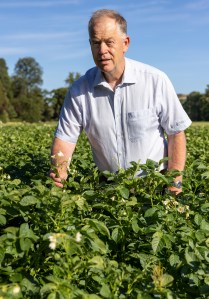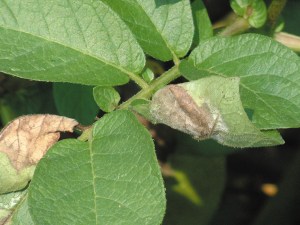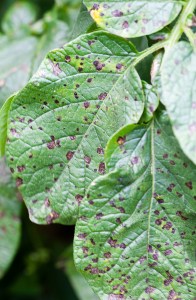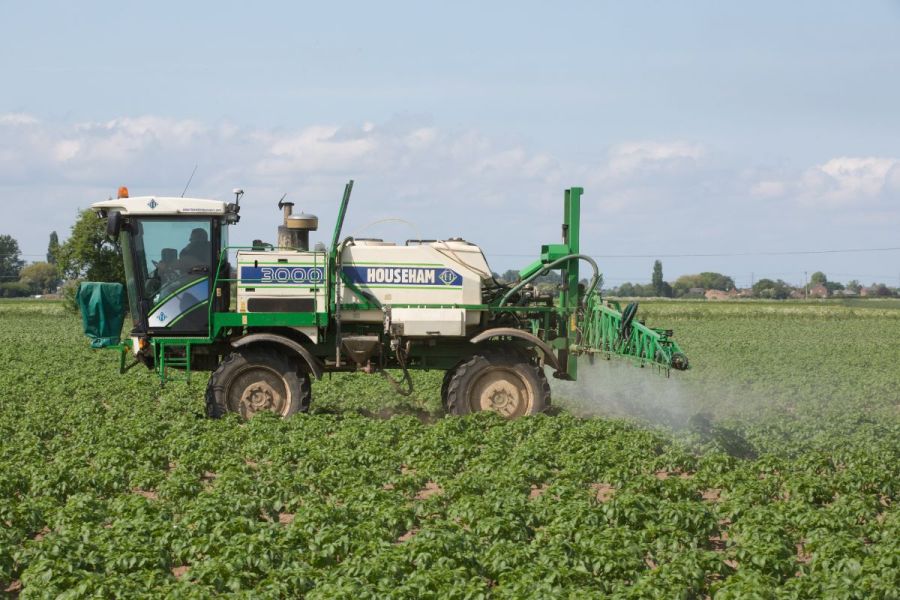A late season and favourable pest and disease conditions may make 2023 a challenging potato season. CPM gathers some sage advice on blight and virus control.
“The 2023 season has all the hallmarks of a challenging year.”
By Lucy de la Pasture
The wettest March for 40-years and regular showers through April means unfavourable ground conditions have stifled hopes of a timely start to the 2023 potato season. The consequence is crops are likely to face an early barrage of pests and disease, warns Eric Anderson, senior agronomist with Scottish Agronomy.

Eric Anderson talks through the challenges posed by application restrictions to the two remaining systemic insecticides for control of control colonising aphids.
“The 2023 season has all the hallmarks of a challenging year. Later planting and rapid haulm growth means crops will likely be under pressure from the outset. But unlike in 2007 or 2018, the range of crop protection products available is considerably smaller, so growers will have to plan ahead if crops are to be protected through to the end of the season,” he says.
Although much discussed, the threat posed by potato viruses remains a real one. The Rothamsted Insect Survey aphid forecast for 2023 suggests aphids will be flying around two weeks earlier in Scotland and northern England and up to a week earlier over much of southern England compared with the historical average – with suction traps picking up the first flights in late April.
“Despite a cold start to winter, it’s the average temperature in January and February that has the greatest influence on when aphids are likely to be found in crops. Average air temperatures during this period were roughly 1oC warmer in Scotland and northern England, and 0.5oC warmer across southern England,” says Eric.
Challenges include application restrictions to the two remaining systemic insecticides to offer any meaningful control of colonising aphids – InSyst (acetamiprid) and Teppeki (flonicamid) – and growers will have to include mineral oils with fungicides to improve potyvirus control (PVY and PVA) from non-colonising aphids.
Growers still have Movento (spirotetramat) as an effective means of controlling PLRV, but restrictions on its use – it cannot be applied to flowering varieties before the end of flowering (BBCH 69) – limit its usefulness, he explains.

The late start to planting means potato crops are likely to emerge into conditions which are conducive for the development of late blight and aphid migration.
“The 2023 label for InSyst states that it can no longer be applied before tuber initiation (BBCH 40). It also states, ‘to protect non-target insects/arthropods do not apply after 31 July’, which precludes any late-season use. Those with old stock with MAPP No 13414 have until 30 June to use it up but this can be applied before tuber initiation, if needed.
“Seed growers can still make two applications of InSyst, while ware growers or those marketing ‘seed tops’ have only one,” he cautions.
“For Teppeki, the practical problem being that ISK – the owner of flonicamid, which Belchim Crop Protection markets as Teppeki and Syngenta markets as Afinto in the UK – advise not to use the products on potatoes until further notice.
“This is a voluntary withdrawal and if growers choose to apply Tepekki to potato crops, they do so at their own risk as ISK has said it will reject all liability for any MRL exceedances. It can still legally be applied to potatoes twice per season, with the manufacturer warning: ‘DO NOT use oil-based adjuvants in a tank mix when applied to ware potatoes’,” he adds.
These specific limitations in potato seed crops means mineral oil (such as Crop Spray 11E) will frequently need to be added to the tank with fungicides. Although both Zorvec Endavia (oxathiapiprolin+ benthiavalicarb) and Crop Spray 11E are physically compatible, Scottish Agronomy advises against mixing the two products.
“It’s our experience that the OD formulation of Zorvec Endavia can, on occasion, react adversely with Crop Spray 11E, increasing the risk of phytotoxic symptoms on crop leaves which may affect the ability for the certifying body to inspect growing crops,” warns Eric.
The loss of effective insecticides in recent years means there’s been a slow, but gradual increase in the area of seed potatoes infected with PLRV virus. The area recorded with PLRV in Scotland nearly doubled between 2021 and 2022, from 5.1% to 9.4%. For PVY, the area recorded fell from 12% to 10% over the same period (as reported in CPM April 2022, page 92).

Alternaria is another disease to be on the lookout for and could add to the cost burden growers are facing as fungicides rocket in price.
“The depth of the virus pool that’s present in seed crops as well as in the surrounding area, for example, in volunteers, shouldn’t be underestimated,” continues Eric. “In these conditions, an integrated pest management (IPM) approach is needed. Mineral oils applied at the start of the season will help, while cultural methods – such as surrounding seed crops with cereals, wild-flower mixes or any other green crop – could provide a cleansing barrier to incoming non-colonising aphids, as they effectively remove the potyvirus virus from the aphid’s stylet as it probes.
When using this technique, Eric advises ensuring the area planted is surrounded by green when the potato crop emerges. “Wildflower mixes are most likely to provide a source of aphid predators later in the season, which is more useful for PLRV suppression. Application of straw to ridges after planting in early field generation (FG 1-3) seed material will also help to reduce the risk to potato seed crops,” he says.
Blight protection
Late blight (Phytophthora infestans), and to a lesser extent early blight (Alternaria species), will also pose a threat to crops, but for different reasons, says Eric. The cost of fungicide programmes is also set to increase as manufacturers seek to pass on higher manufacturing costs.
“Some manufacturers are still finalising 2023 prices, but we’ve been warned that the cost of some well-known products will increase significantly, in some cases by as much as 40%. Even off-patent actives, such as mancozeb, are up by about 20% on last year,” he says.
Product cost and availability issues aside, the main development to affect late blight programmes for 2023 is the rapid spread of CAA-resistant genotype 43_A1 in Europe. While it’s yet to be confirmed in Great Britain, it would be prudent to consider when setting out a programme, believes Eric.
“Carboxylic Acid Amides (CAA) group fungicides, such as Revus (mandipropamid), Carial Flex (mandipropamid+ cymoxanil) or Carial Star (mandipropamid+ difenoconazole), still have a place in an early and mid-season programme.
However, Eric’s mindful of heeding the lessons of 2018, when fluazinam-resistant 37_A2 caught many off-guard. “As such, CAA group fungicides should no longer be applied alone. Instead, they should be mixed with either mancozeb, of which there is a plentiful supply, or if it’s available to you, ametoctradin, plus oil for potyvirus control.”
Alternatively, growers can use Bayer’s Infinito (fluopicolide+ propamocarb) plus mineral oil for potyvirus control prior to tuber initiation.
“Infinito has the advantage of not needing to be mixed with a partner as fluopicolide and propamocarb belong to different mode of action groups with no known sensitivity concerns. Ranman Top (cyazofamid) should be mixed with either mancozeb or ametoctradin to protect its efficacy, which increases the relative cost,” he says.
EU36_A2 was the single most prevalent genotype sampled across GB (53% of samples) and Europe (36% of the samples) in 2022. This spread, plus evidence from laboratory studies, and anecdotal evidence of it being challenging to manage, suggest it has an increased fitness over other genotypes. There’s no evidence of any shifts in its sensitivity but the genotype is known to produce more spores with a shorter latent period, higher leaf lesion growth rate and it has a much higher sporulation capacity.
“In this context, the risk of tuber blight is a perennial threat, especially in ware crops as these have a longer growing season. So in the presence of active late blight, there needs to be greater emphasis on products with an anti-sporulant and zoospore component, such as Infinito, or a zoospore component such as Ranman Top tank mixed with anti-sporulant Axidor or Proxanil (both propamocarb+ cymoxanil),” he says.
The wider issue is how the spread of the aggressive 43_A1 genotype across Europe from Scandinavia, through the low countries to Portugal is placing pressure on the programme and specifically, the use of CAA chemistry, such as dimethomorph, benthiavalicarb and mandipropamid. In an attempt to preserve their efficacy for future seasons, the Fungicide Resistance Action Committee (FRAC) places strict limitations on the amount and times these products can be used in a season.
“Without good planning, it’s possible to use up the allocated applications before the end of the season. To ensure the flexibility needed, it makes sense to utilise the permitted four applications of Infinito otherwise it can get difficult very quickly,” concludes Eric.
This article was taken from the latest issue of CPM. For more articles like this, subscribe here.
Sign up for Crop Production Magazine’s FREE e-newsletter here.




